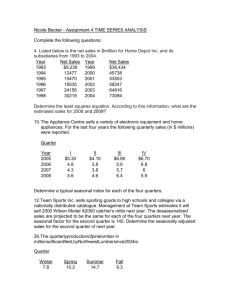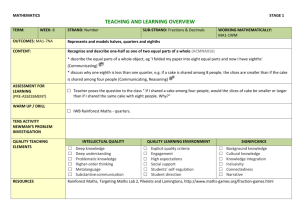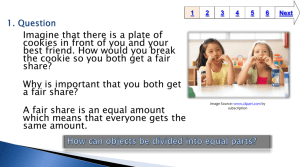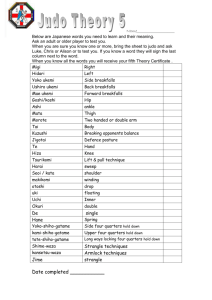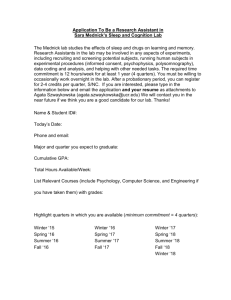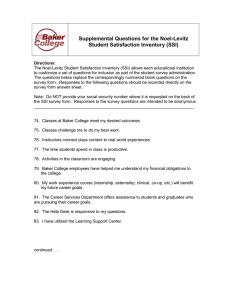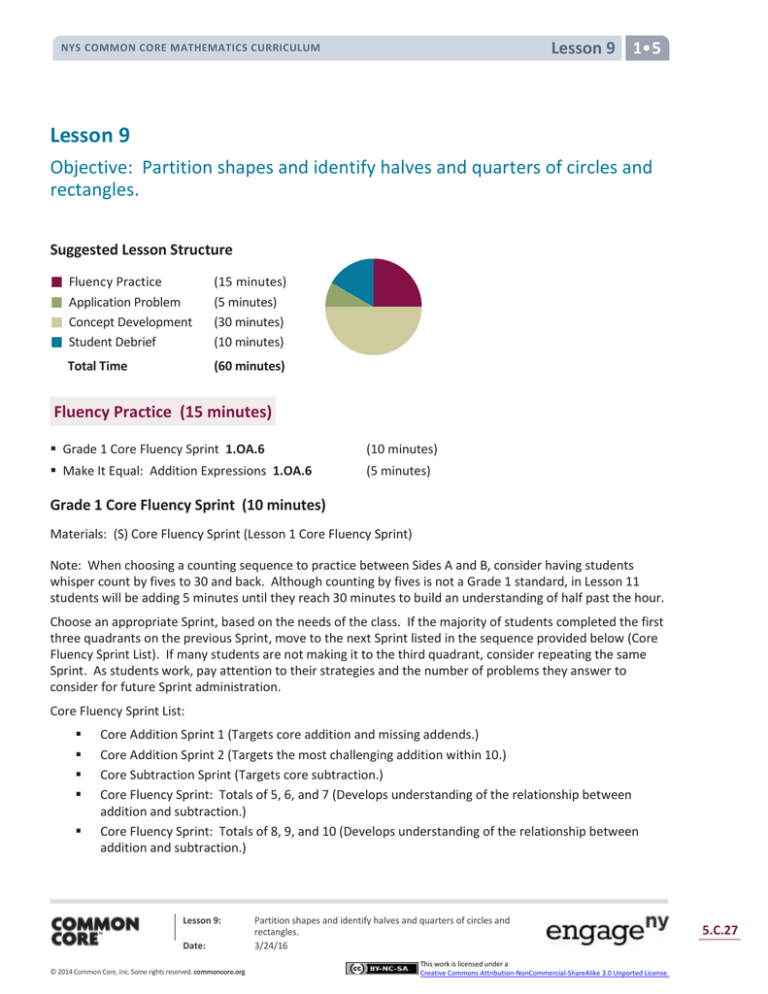
Lesson 9 1
NYS COMMON CORE MATHEMATICS CURRICULUM
Lesson 9
Objective: Partition shapes and identify halves and quarters of circles and
rectangles.
Suggested Lesson Structure
Fluency Practice
Application Problem
Concept Development
Student Debrief
Total Time
(15 minutes)
(5 minutes)
(30 minutes)
(10 minutes)
(60 minutes)
Fluency Practice (15 minutes)
Grade 1 Core Fluency Sprint 1.OA.6
(10 minutes)
Make It Equal: Addition Expressions 1.OA.6
(5 minutes)
Grade 1 Core Fluency Sprint (10 minutes)
Materials: (S) Core Fluency Sprint (Lesson 1 Core Fluency Sprint)
Note: When choosing a counting sequence to practice between Sides A and B, consider having students
whisper count by fives to 30 and back. Although counting by fives is not a Grade 1 standard, in Lesson 11
students will be adding 5 minutes until they reach 30 minutes to build an understanding of half past the hour.
Choose an appropriate Sprint, based on the needs of the class. If the majority of students completed the first
three quadrants on the previous Sprint, move to the next Sprint listed in the sequence provided below (Core
Fluency Sprint List). If many students are not making it to the third quadrant, consider repeating the same
Sprint. As students work, pay attention to their strategies and the number of problems they answer to
consider for future Sprint administration.
Core Fluency Sprint List:
Core Addition Sprint 1 (Targets core addition and missing addends.)
Core Addition Sprint 2 (Targets the most challenging addition within 10.)
Core Subtraction Sprint (Targets core subtraction.)
Core Fluency Sprint: Totals of 5, 6, and 7 (Develops understanding of the relationship between
addition and subtraction.)
Core Fluency Sprint: Totals of 8, 9, and 10 (Develops understanding of the relationship between
addition and subtraction.)
Lesson 9:
Date:
© 2014 Common Core, Inc. Some rights reserved. commoncore.org
Partition shapes and identify halves and quarters of circles and
rectangles.
3/24/16
This work is licensed under a
Creative Commons Attribution-NonCommercial-ShareAlike 3.0 Unported License.
5.C.27
Lesson 9 1
NYS COMMON CORE MATHEMATICS CURRICULUM
Make It Equal: Addition Expressions (5 minutes)
Materials: (S) Numeral cards (Lesson 1 Fluency Template), one =card, two + cards
Note: This activity builds fluency with Grade 1’s core addition facts and promotes an understanding of
equality. The suggested sets move from simple to complex so students can progress through them at their
own rate.
Assign students partners of equal ability. Students arrange numeral cards from 0 to 10, including the extra 5.
Place the = card between partners. Write or project the suggested sets. Partners take the numeral cards that
match the numbers written to make two equivalent expressions (e.g., 10 + 0 = 5 + 5).
Suggested sets: a) 10, 0, 5, 5
b) 9, 8, 2, 1
c) 3, 6, 4, 7
d) 1, 2, 6, 5
e) 1, 2, 5, 4
f) 3, 5, 4, 2
g) 2, 3, 5, 6
h) 3, 4, 5, 6
i) 4, 5, 9, 10
j) 9, 3, 2, 8
k) 8, 5, 9, 4
l) 5, 6, 8, 7
Application Problem (5 minutes)
Emi cut a square brownie into fourths. Draw a picture of the brownie. Emi
gave away 3 parts of the brownie. How many pieces does she have left?
Extension: What part, or fraction, of the whole brownie is left?
Note: Today’s Application Problem provides students with the opportunity to
apply the terminology of fourths. Students solve the relatively familiar take
away with result unknown problem type using fractions as a type of unit.
Concept Development (30 minutes)
Materials: (T) Chart paper, 2 pieces of blank paper of the same size (preferably different colors), document
camera (S) Pairs of shapes (Template), personal white board
Gather students in the meeting area with the pairs of shapes
template inserted into their personal white boards.
T:
T:
T:
S:
T:
T:
Partner A, draw one line to cut your pizza into halves.
Partner B, draw two lines to cut your pizza into
quarters.
Who has more slices?
Partner B has more slices. Partner B has four slices;
Partner A only has two slices.
Partner A, color one slice of your pizza. Show me your
slice.
Partner B, color one slice of your pizza. Show me your
slice.
Lesson 9:
Date:
© 2014 Common Core, Inc. Some rights reserved. commoncore.org
NOTES ON
MULTIPLE MEANS
OF ENGAGEMENT:
For kinesthetic learners, it may be
beneficial to provide two pieces of
blank paper to student partners and
have the students cut one fourth from
one paper and one half from another
paper along with the teacher.
Partition shapes and identify halves and quarters of circles and
rectangles.
3/24/16
This work is licensed under a
Creative Commons Attribution-NonCommercial-ShareAlike 3.0 Unported License.
5.C.28
Lesson 9 1
NYS COMMON CORE MATHEMATICS CURRICULUM
T:
T:
S:
T:
S:
T:
S:
Partners, put your half and your quarter next to each other.
Point to the piece of pizza that is larger. Whose piece is larger?
Partner A’s.
Now, look at your whole pizza. Who has a larger number of slices?
Partner B has more slices. Partner B has four slices of pizza. Partner A only has two slices of
pizza.
Do you want one half of a yummy pizza or one quarter of a yummy pizza? Discuss this with your
partner. Explain your choice. (Listen as students share their thinking, and then repeat the question
before having students answer.)
I want one half of the pizza because a half is larger than one quarter of the pizza. To get one
quarter of the pizza, you have to cut the two halves of the pizza in half again. That’s a lot smaller. I
would want one half of the pizza. You need two quarters of the pizza to have the same amount as
one half of the pizza.
Draw two circles of equal size on the board. Invite a student volunteer to draw a line to cut the first circle
into two halves. Ask the student to color in one half. Label as one half of the circle. Repeat the process with
the other circle, coloring in and labeling one fourth of the circle.
T:
T:
T:
S:
T:
T:
S:
T:
S:
T:
S:
T:
Let’s try that with the rectangles and see if that’s still true. This time, I’ll use paper to actually cut
and compare. Which will be larger, one half of this piece of paper or one fourth of the paper? Talk
with your partner, and explain your thinking. (Listen as students share their thinking.)
I’m going to fold the paper first to be sure I’m cutting equal parts. (Fold and cut the paper into
halves. Ask a student volunteer to hold one half.)
How much of the paper is he holding?
One half of the paper!
NOTES ON
MULTIPLE MEANS
Let’s cut this same-size piece of paper into four equal
parts now, so we can compare one fourth, or one
OF REPRESENTATION:
quarter of the paper with one half of the paper. This
To support students’ vocabulary
time, I’m going to fold the paper in half and then in half
development, write one fourth of
again to make four equal parts. (Fold and cut paper
paper on each of the four equal pieces
into fourths.)
of paper and one half of paper on each
of the two equal pieces of paper.
Are all of my parts equal?
These can be posted in the room as a
Yes!
reference, helping students visualize
How much of the paper is each piece?
the concept as well as the relationship
between concepts.
One fourth of the paper! (Or, one quarter of the
paper.)
(Ask a student volunteer to hold one fourth next to the student who is holding one half.) Which
piece is larger, or greater, one half of the paper or one fourth of the paper?
One half of the paper!
How many pieces did we make when we cut the paper
into halves?
Lesson 9:
Date:
© 2014 Common Core, Inc. Some rights reserved. commoncore.org
Partition shapes and identify halves and quarters of circles and
rectangles.
3/24/16
This work is licensed under a
Creative Commons Attribution-NonCommercial-ShareAlike 3.0 Unported License.
5.C.29
Lesson 9 1
NYS COMMON CORE MATHEMATICS CURRICULUM
S:
T:
S:
T:
T:
S:
T:
S:
T:
Two pieces.
How many pieces did we make when we cut the
paper into quarters?
Four pieces.
So, when we cut the paper into two pieces to
make halves, our pieces were this size. (Hold up
halves.)
What happened to the size of our pieces when
we cut the same size paper into four pieces to
make quarters?
The parts became smaller.
Why are the pieces smaller now? Talk to your
partner.
We cut the paper into more pieces. We have
more parts, but each part is smaller. The piece
of paper is the same size, so if you cut it up into
more equal parts, the parts will be smaller.
On your personal white boards, you have pairs of
the same shape. Draw lines and color in one half
of the first shape, and then draw lines and color
in one quarter, or one fourth, of the other shape.
With your partner, see if one fourth is smaller
than one half every time, or just sometimes.
When most students have completed the task, have
students show their personal white boards under the
document camera and explain their findings.
Problem Set (10 minutes)
Students should do their personal best to complete the
Problem Set within the allotted 10 minutes. For some
classes, it may be appropriate to modify the assignment by
specifying which problems they work on first.
Student Debrief (10 minutes)
Lesson Objective: Partition shapes and identify halves and
quarters of circles and rectangles.
The Student Debrief is intended to invite reflection and
active processing of the total lesson experience.
Lesson 9:
Date:
© 2014 Common Core, Inc. Some rights reserved. commoncore.org
Partition shapes and identify halves and quarters of circles and
rectangles.
3/24/16
This work is licensed under a
Creative Commons Attribution-NonCommercial-ShareAlike 3.0 Unported License.
5.C.30
Lesson 9 1
NYS COMMON CORE MATHEMATICS CURRICULUM
Invite students to review their solutions for the Problem Set. They should check work by comparing answers
with a partner before going over answers as a class. Look for misconceptions or misunderstandings that can
be addressed in the Debrief. Guide students in a conversation to debrief the Problem Set and process the
lesson.
Any combination of the questions below may be used to lead the discussion.
Look at Problem 1. Which shaded part is greater, or larger? Is this true for your other problems? Is
one half of a shape always larger than one fourth of the same shape?
If you want more pieces, should you cut your shape into halves or quarters? If you want larger
pieces, should you cut your shape into halves or quarters? Explain your thinking.
Why does cutting something into fourths make the equal parts smaller than cutting it into halves?
Let’s think about the first question I asked you today. Would you rather have one half of a yummy
pizza or one quarter of a yummy pizza? Explain your thinking. (Choose students who may be better
able to express accurate reasoning since participating in the lesson.)
Look at the Application Problem. Share your drawing with your partner. Did you cut your brownie
into quarters in the same way or in a different way? How did you make sure you created four equal
parts?
Exit Ticket (3 minutes)
After the Student Debrief, instruct students to complete the Exit Ticket. A review of their work will help with
assessing students’ understanding of the concepts that were presented in today’s lesson and planning more
effectively for future lessons. The questions may be read aloud to the students.
Lesson 9:
Date:
© 2014 Common Core, Inc. Some rights reserved. commoncore.org
Partition shapes and identify halves and quarters of circles and
rectangles.
3/24/16
This work is licensed under a
Creative Commons Attribution-NonCommercial-ShareAlike 3.0 Unported License.
5.C.31
Lesson 9 Problem Set 1
NYS COMMON CORE MATHEMATICS CURRICULUM
Name
Date
Label the shaded part of each picture as one half of the shape or one quarter of the
shape.
Which shape has been cut into more equal
1.
parts? ____
Which shape has larger equal parts? ___
A
Which shape has smaller equal parts? ___
B
2.
Which shape has been cut into more equal
parts? ____
Which shape has larger equal parts? ___
B
A
Which shape has smaller equal parts? ___
3. Circle the shape that has a larger shaded part. Circle the phrase that makes the
sentence true.
The larger shaded part is
(one half of / one quarter of)
the whole shape.
Lesson 9:
Date:
© 2014 Common Core, Inc. Some rights reserved. commoncore.org
Partition shapes and identify halves and quarters of circles and
rectangles.
3/24/16
This work is licensed under a
Creative Commons Attribution-NonCommercial-ShareAlike 3.0 Unported License.
5.C.32
Lesson 9 Problem Set 1
NYS COMMON CORE MATHEMATICS CURRICULUM
Color part of the shape to match its label.
Circle the phrase that would make the statement true.
4.
One half of the circle
is larger than
one fourth of the circle.
is smaller than
is the same size as
5.
One quarter of the rectangle
is larger than
one half of the rectangle.
is smaller than
is the same size as
6.
One quarter of the square
is larger than
one fourth of the square.
is smaller than
is the same size as
Lesson 9:
Date:
© 2014 Common Core, Inc. Some rights reserved. commoncore.org
Partition shapes and identify halves and quarters of circles and
rectangles.
3/24/16
This work is licensed under a
Creative Commons Attribution-NonCommercial-ShareAlike 3.0 Unported License.
5.C.33
NYS COMMON CORE MATHEMATICS CURRICULUM
Name
Lesson 9 Exit Ticket 1
Date
1. Circle T for true or F for false.
a. One fourth of the circle is larger than one half of the circle.
T
F
b. Cutting the circle into quarters gives you more pieces than
cutting the circle into halves.
T
F
2. Explain your answers using the circles below.
Lesson 9:
Date:
© 2014 Common Core, Inc. Some rights reserved. commoncore.org
Partition shapes and identify halves and quarters of circles and
rectangles.
3/24/16
This work is licensed under a
Creative Commons Attribution-NonCommercial-ShareAlike 3.0 Unported License.
5.C.34
Lesson 9 Homework 1
NYS COMMON CORE MATHEMATICS CURRICULUM
Name
Date
1. Label the shaded part of each picture as one half of the shape or one quarter of
the shape.
Which picture has been cut into more equal parts? ____
A
Which picture has larger equal parts? ___
Which picture has smaller equal parts? ___
B
A
2. Write whether the shaded part of each shape is a half or a quarter.
a.
b.
__________
__________
c.
__________
__________
__________
__________
d.
__________
__________
Lesson 9:
Date:
© 2014 Common Core, Inc. Some rights reserved. commoncore.org
Partition shapes and identify halves and quarters of circles and
rectangles.
3/24/16
This work is licensed under a
Creative Commons Attribution-NonCommercial-ShareAlike 3.0 Unported License.
5.C.35
Lesson 9 Homework 1
NYS COMMON CORE MATHEMATICS CURRICULUM
3. Color part of the shape to match its label. Circle the phrase that would make the
statement true.
a.
One quarter of the square
one half of the square.
is larger than
is smaller than
is the same size as
b.
is larger than
is smaller than
One quarter of the rectangle
one fourth of the rectangle.
is the same size as
Lesson 9:
Date:
© 2014 Common Core, Inc. Some rights reserved. commoncore.org
Partition shapes and identify halves and quarters of circles and
rectangles.
3/24/16
This work is licensed under a
Creative Commons Attribution-NonCommercial-ShareAlike 3.0 Unported License.
5.C.36
NYS COMMON CORE MATHEMATICS CURRICULUM
Lesson 9 Template 1
pairs of shapes
Lesson 9:
Date:
© 2014 Common Core, Inc. Some rights reserved. commoncore.org
Partition shapes and identify halves and quarters of circles and
rectangles.
3/24/16
This work is licensed under a
Creative Commons Attribution-NonCommercial-ShareAlike 3.0 Unported License.
5.C.37

